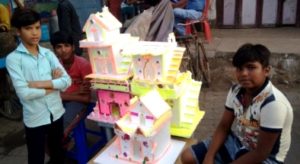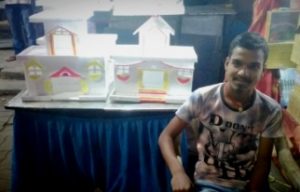[My Diwali: a collection of personal perspectives from our readers, contributors, and interns. In this piece Mahtab Alam looks around Ara, Bihar and finds something beautiful]
Diwali, the festival of lights is due in a day, and the lights of festival can be seen everywhere. Streets are crowded, markets are up, and no amount of shopping seems enough.
This cultural festival is a different mean to different people: from satisfying your shoppers soul, to enjoying the sweets and lights; and for families living apart, Diwali is a reunion. For these three kids- Asif, Arif and Amir (brothers), Diwali is a mean to support their poverty stricken family, while also delighting their artists within.

“We will sell these from tomorrow”, explained Asif when I found them making their gharondas (dolly homes) the day before Dhanteras, in the deckings outside their home. Sold for anything between ₹150 to 200 each (and they sell about 15 to 20), the gharondas (which are like dolls houses) bring some good cash home for Diwali every year. But this isn’t about money itself, they enjoy crafting, and they enjoy making and selling their art work together (apparently, they’d love anything as long as they do it together).
Opposite these kids in the market near Town Thana in the town of Ara, is another footpath shop of gharondas. This one has comparatively bigger and more precisely made gharondas. Anshu is a college student, and like those three brothers, he too likes to bring home some extra cash every Diwali. Anshu was happy to share with me that his sisters make these gharondas at home, while he sells them outside.

While these kids make gharondas made of thermocol, these are also made of wood and paper, and can be found in different sizes, designs and colours. And while the readymade market is good to meet the wishes of urban busy lives, crafting one’s own gharonda remains a timeless custom. One such classical person is Tabassum. She’s been making her gharonda every Diwali ever since she was a child (she’s only 24 now btw), and she loves decorating it more than she loves the festival itself.
Decorating gharondas is one of the many customs of Diwali, and it is indeed a healthy and eco-friendly one.
Unlike the addition (boost) of the practice of bursting firecrackers in mid-20th century with the coming of first fireworks industry in Tamil Nadu, the custom of gharondas is as old as the festival itself. It is said that the people of Ayodhya, it was only through the return of lord Rama that their city was nestled again, and so began the custom of decorating gharondas.
Besides, the widely enjoyed practice of diya and rangoli are also some other harmless practices one could divert to, instead of hurting one’s own lungs playing with firecrackers.
Mehtab Alam


